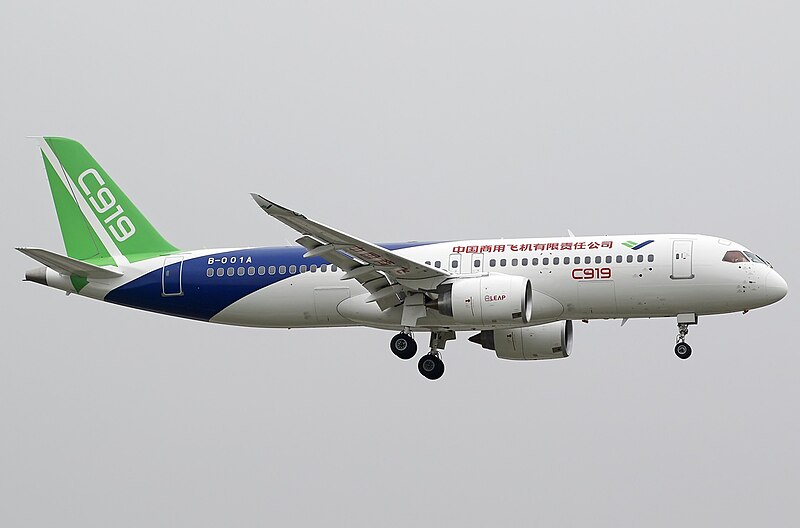Airlines
Comac &Tibet Airlines partner to develop a high-altitude C919 variant

Comac, China’s state-owned commercial aircraft manufacturer, has entered into a partnership with Tibet Airlines to collaborate on the development of a Chinese-made airliner specifically designed for high-altitude plateau operations.
This initiative marks Tibet Airlines as the first carrier in China to engage in the creation of a variant of the narrow-body aircraft. As part of the agreement signed in Shanghai, the two entities will establish a national-level research center focused on the high-altitude operation of large jets.
The primary objective is to promote the operational capabilities and technological advancements of Comac’s existing ARJ21 and C919 aircraft models. The proposed C919 plateau variant is tailored for airports situated at high altitudes and is designed to accommodate 140 passengers, 28 fewer than the standard model.
With a range of 3,000 kilometers, a prototype of the aircraft was showcased at the China International Import Expo and the Shanghai International Commercial Airshow earlier this year. The C919 plateau variant, at approximately 34 meters in length, will be 3.6 meters shorter than the basic C919 model but will retain standard wings and engines.
This specialized model aims to address the unique requirements of air transport in western China and is well-suited for plateau airports. Comac asserts that it is not only adapted to challenging environmental conditions but is also cost-effective. Wang Yanan, the chief editor of Beijing-based Aerospace Knowledge magazine, highlighted that this development will establish a foundation for the potential export of C919 aircraft to countries neighboring Xizang, such as Nepal, and other nations with high-altitude airports like Mexico.

Airlines
Air India Rolls Out A350s for Delhi-New York JFK and Newark Routes

In a major development for North American travelers, Air India has announced the deployment of its state-of-the-art Airbus A350-900 aircraft on two key routes: Delhi to New York and Delhi to Newark.
The service on the Delhi-New York route will commence on November 1, 2024, while the Delhi-Newark route will see its inaugural flight on January 2, 2025.
The introduction of the air india a350 will bring significant enhancements to Air India’s offerings, particularly with the launch of its Premium Economy class. air india retrofit This new class will feature 24 wide seats arranged in a 2-4-2 configuration, providing passengers with extra legroom and a more comfortable flying experience.
Soon, Air India aircraft will feature onboard WiFi & all-new cabins: Click here
“We are encouraged by the positive guest feedback we have received from the domestic deployment of our air india a350 interior to offer our hero product on the Delhi-New York JFK and Delhi-Newark routes. This is a significant leap forward for our U.S. operations that also underscores our commitment to continuous improvement,” said Campbell Wilson, Chief Executive Officer & Managing Director of Air India.
The A350’s Business class will set new standards with 28 private suites, each equipped with full-flat beds, direct aisle access, and personal wardrobes. Economy class will be configured to accommodate 264 passengers in a 3-4-3 layout. Across all cabins, passengers will enjoy the latest Panasonic eX3 in-flight entertainment system, offering over 2,200 hours of content.
Air India’s First A350-900: Interior, Routes, &Inflight Features: Click here
This strategic deployment marks a notable enhancement in Air India’s U.S. operations, with 60% of its flights to the U.S. now featuring new or upgraded cabin interiors. The air india new international routes currently operates 51 weekly flights to five U.S. destinations: New York JFK, Newark, Washington DC, Chicago, and San Francisco.
The revamped cabins, advanced in-flight entertainment systems, and improved service standards represent air india wifi commitment to providing a superior travel experience. “We believe this enhanced offering will solidify Air India’s position as a leading carrier and attract travellers seeking a world-class flying experience between India and the United States,” the airline stated.
Seats on these flights are now available for booking on Air India’s website, mobile app, and through travel agents, ensuring that passengers can easily plan their journeys on these newly upgraded routes.
Air India Economy vs Qatar airways economy: which is best?:Click here
-

 Travel1 week ago
Travel1 week agoAir India to Expand US Operations with Three New Routes After a Decade
-

 Travel2 weeks ago
Travel2 weeks agoWhy We Should Avoid These Stamps in a Passport
-

 Airlines1 month ago
Airlines1 month agoInvestigations Reveal Fake Chinese Titanium in Boeing and Airbus Jets
-

 Tech4 weeks ago
Tech4 weeks agoChina’s CATL Plans 1,800-Mile Electric Plane Launch by 2027
-

 Airport3 days ago
Airport3 days agoTop 10 Largest Airports in the World by Size
-

 Aerospace4 weeks ago
Aerospace4 weeks agoChina’s Fighter Jets Turn Wings into Autonomous Drones
-

 Airlines4 days ago
Airlines4 days agoAir India Rolls Out A350s for Delhi-New York JFK and Newark Routes
-

 Defence3 weeks ago
Defence3 weeks agoBoeing Enhances Chinook with New Engines and Block II Upgrades at $96 Million







